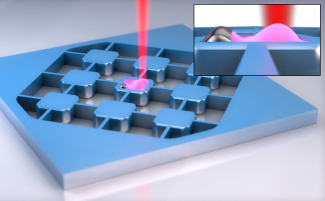Qubits are a basic building block for quantum computers, but they’re also notoriously fragile—tricky to observe without erasing their information in the process. Now, new research from CU Boulder and the National Institute of Standards and Technology (NIST) may be a leap forward for handling qubits with a light touch.
In the study, a team of physicists demonstrated that it could read out the signals from a type of qubit called a superconducting qubit using laser light—and without destroying the qubit at the same time.
Artist's depiction of an electro-optic transducer, an ultra-thin wafer that can read out the information from a superconducting qubit.
Artist's depiction of an electro-optic transducer, an ultra-thin device that can capture and transform the signals coming from a superconducting qubit. (Credit: Steven Burrows/JILA)
The group’s results could be a major step toward building a quantum internet, the researchers say. Such a network would link up dozens or even hundreds of quantum chips, allowing engineers to solve problems that are beyond the reach of even the fastest supercomputers around today. They could also, theoretically, use a similar set of tools to send unbreakable codes over long distances.
The study, published June 15 in the journal Nature, was led by JILA, a joint research institute between CU Boulder and NIST.
To read the full article, click here
Written by University of Colorado Boulder's Office of Strategic Communications and Relations Writer, Dan Strain



 The Physics Frontiers Centers (PFC) program supports university-based centers and institutes where the collective efforts of a larger group of individuals can enable transformational advances in the most promising research areas. The program is designed to foster major breakthroughs at the intellectual frontiers of physics by providing needed resources such as combinations of talents, skills, disciplines, and/or specialized infrastructure, not usually available to individual investigators or small groups, in an environment in which the collective efforts of the larger group can be shown to be seminal to promoting significant progress in the science and the education of students. PFCs also include creative, substantive activities aimed at enhancing education, broadening participation of traditionally underrepresented groups, and outreach to the scientific community and general public.
The Physics Frontiers Centers (PFC) program supports university-based centers and institutes where the collective efforts of a larger group of individuals can enable transformational advances in the most promising research areas. The program is designed to foster major breakthroughs at the intellectual frontiers of physics by providing needed resources such as combinations of talents, skills, disciplines, and/or specialized infrastructure, not usually available to individual investigators or small groups, in an environment in which the collective efforts of the larger group can be shown to be seminal to promoting significant progress in the science and the education of students. PFCs also include creative, substantive activities aimed at enhancing education, broadening participation of traditionally underrepresented groups, and outreach to the scientific community and general public.